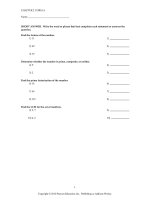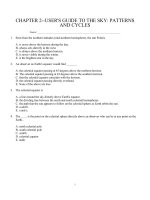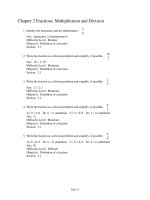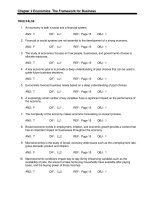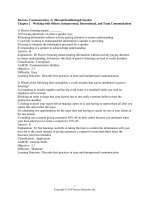CHEM 2 chemistry in your world 2nd edition hogg test bank
Bạn đang xem bản rút gọn của tài liệu. Xem và tải ngay bản đầy đủ của tài liệu tại đây (661.67 KB, 10 trang )
Chapter 2—The Chemical View of Matter
MULTIPLE CHOICE
1. Which of the following is not one of the common states of matter?
a. solid
b. plasma
c. liquid
d. gas
ANS: B
2. Which of the following is one of the classes of pure substances?
a. compound
b. homogeneous mixture
c. solution
d. heterogeneous mixture
ANS: A
3. Which is not a mixture?
a. pure water
b. mayonnaise
c. strawberry Kool-Aid® drink
d. rock
ANS: A
4. Most samples of matter occur in nature as
a. elements.
b. compounds.
c. homogeneous samples.
d. mixtures.
ANS: D
5. Separating a mixture of iron and sulfur can be done
a. by filtration.
b. dissolving in water.
c. with a magnet.
d. by burning.
ANS: C
6. Which statement describes a physical property of oxygen?
a. Oxygen supports burning of gasoline.
b. Oxygen has a density of 0.0014 g/mL.
c. Oxygen is required for human metabolism of food.
d. Oxygen combines with iron causing the formation of rust.
ANS: B
7. Which is a chemical property?
a. boiling point
b. state
CHEM2
Chapter 2
The Chemical View of Our World
c. odor
d. flammability
ANS: D
8. A process is probably a chemical reaction if
a. it produces light.
b. a solid appears when two solutions are mixed.
c. bubbles start to form when two substances are mixed.
d. all of these
ANS: D
9. Which of the following is not a chemical change?
a. burning charcoal
b. rusting iron
c. melting ice
d. baking bread
ANS: C
10. Which term describes energy?
a. motion
b. heat
c. light
d. all of these
ANS: D
11. Alfred Nobel ____________?
a. discovered dynamite
b. proposed the metric system
c. developed the STM, scanning tunneling microscope
d. discovered kinetic energy
ANS: A
12. Which mixture is heterogeneous?
a. salt and water
b. water and oil
c. sweetened hot tea
d. Ivory soap bar
ANS: B
13. The element whose name is derived from the Latin aurum, meaning shining dawn
a. gold.
b. aluminum.
c. silver.
d. chromium.
ANS: A
2
CHEM2
Chapter 2
The Chemical View of Our World
14. Which of the following elements is a metal?
a. Ca, calcium
b. Na, sodium
c. Hg, mercury
d. all of these
ANS: D
15. Sublimation is a characteristic physical property of
a. chlorine (Cl2, liquid).
b. oxygen (O2, gas).
c. bromine (Br2, liquid).
d. iodine (I2, solid).
ANS: D
16. What information is not provided by the formula, C4H10, for butane?
a. butane being an organic compound
b. the molecular formula
c. the relative number of atoms of each kind
d. the shape of the molecule
ANS: D
17. Which of the following sets, is a list of the symbols for an element and a compound (in that order)?
a. Mg, CO
b. CO, CO2
c. CO, Co
d. H2O2, P
ANS: A
18. Which of the following sets, is a list of the symbols that could represent the following substances,
respectively?
lead
a.
b.
c.
d.
a compound of equal parts hydrogen and oxygen
elemental oxygen
PB, H2O2, O
Pb, HO, O
Pb, H2O2, O2
PB, HO, O2
ANS: C
19. In the balanced equation, 2 Al + 6 HCl 2 AlCl3 + 3 H2, the sum of the coefficients of the reactants is
a. 5.
b. 8.
c. 13.
d. none of these
ANS: B
3
CHEM2
Chapter 2
The Chemical View of Our World
20. The equation, 2 C(s) + O2(g) 2 CO(g), tells us
a. the number of atoms of each kind in reactants and products is the same.
b. carbon monoxide (CO) is a product.
c. two atoms of carbon undergo reaction.
d. all of these
ANS: D
21. How does the known number of nonmetals compare to that of metals?
a. There are fewer metals.
b. There are an equal number of each.
c. There are fewer nonmetals.
d. This cannot be predicted because not all metals and nonmetals have been discovered.
ANS: C
22. What prefix is the largest?
a. mega
b. centi
c. micro
d. kilo
ANS: A
23. A person weighs 165 lbs. Which of the following would calculate their mass in kilograms if 2.2 lbs = 1
kg?
a. 165 2.2
b. 165 ÷ 2.2
c. 2.2 ÷ 165
d. 165 + 2.2
ANS: B
24. The quantity 10-9 (one billionth) is designated by the prefix
a. pico.
b. nano.
c. centi.
d. mega.
ANS: B
25. Which of the following would convert 15 L of gasoline to gallons? (1.06 qt = 1 L ; 4 qts = 1 gal)
a. (15) (1.06/1) (1/4)
b. (15) (1/1.06) (4/1)
c. (15) (1.06/1) (4/1)
d. (15) (1/1.06) (1/4)
ANS: A
4
CHEM2
Chapter 2
The Chemical View of Our World
26. An example of a homogeneous mixture is
a. oil in water.
b. a salt water solution.
c. a suspension.
d. a pure substance.
ANS: B
27. Which of the following is not a pure substance?
a. pure gold
b. clean air
c. refined sugar
d. distilled water
ANS: B
28. Which state of matter is composed of charged particles which are dramatically affected by electric and
magnetic fields?
a. solids
b. liquids
c. gases
d. plasmas
ANS: D
29. How many categories of pure substances exist?
a. 2
b. 3
c. thousands
d. about 100
ANS: A
30. A pure substance which can be decomposed into two or more pure substances is a(n)
a. element.
b. compound.
c. mixture.
d. colloid.
ANS: B
31. For which of the following is it necessary that there be a definite composition which cannot vary?
a. mixture
b. solution
c. compound
d. colloid
ANS: C
5
CHEM2
Chapter 2
32. How many phosphorus atoms are in the formula H3PO4?
a. 4
b. 3
c. 7
d. 1
ANS: D
33. How many chemical formulas are in this chemical equation?
P4(s) + 6 F2(g) 4 PF3(g)
a.
b.
c.
d.
2
3
4
11
ANS: B
34. Which of the following is an SI unit of ?
a. pound
b. kilogram
c. quart
d. calorie
ANS: B
35. Potential energy is defined as
a. heat energy.
b. energy associated with motion.
c. stored energy.
d. the ability to do work.
ANS: C
36. Which of the following is a physical change?
a. souring of milk
b. ripening of fruit
c. frying an egg
d. melting
ANS: D
37. The simplest form of matter is a(n)
a. element.
b. mixture.
c. compound.
d. solution.
ANS: A
6
The Chemical View of Our World
CHEM2
Chapter 2
The Chemical View of Our World
38. Which of the following is a compound?
a. mercury
b. blood
c. sugar
d. air
ANS: C
39. How would you separate a mixture of salt, sand, and water?
a. by filtration, followed by evaporation
b. freezing, followed by melting
c. separating with tweezers, followed by evaporation
d. by filtration, followed by burning
ANS: A
40. Which of the following is a physical property?
a. freezing point
b. color
c. odor
d. all of the above
ANS: D
41. Which of the following is an example of a chemical change?
a. boiling water
b. iodine sublimating
c. barbecuing a steak
d. breaking a piece of glass
ANS: C
42. Identify the nonmetal among those listed below.
a. Fe
b. Na
c. S
d. Ag
ANS: C
43. What is the coefficient in front of iron when the following equation is balanced?
Fe + O2 Fe2O3
a.
b.
c.
d.
1
2
4
6
ANS: C
7
CHEM2
Chapter 2
The Chemical View of Our World
44. How many millimeters are in 100 cm?
a. 10
b. 1000
c. 100
d. 1
ANS: B
45. Which of the following has the highest kinetic energy?
a. boulder on the top of hill
b. water behind a dam
c. a ball falling from a 3 story building
d. a piece of wood
ANS: C
46. What kind of change is depicted in the following image?
a.
b.
c.
d.
chemical change
physical change
both a chemical change and a physical change
There is no change shown in the image.
ANS: A
TRUE/FALSE
1. A pure substance which can be decomposed into two or more pure substances is called a mixture.
ANS: F
2. 10 mg is larger than 100 ng.
ANS: T
3. Glucose has the chemical formula C6H12O6. In one molecule of glucose there are 24 atoms.
ANS: T
4. The density of copper is 8.96 g/mL and that of gold is 19.3 g/mL. The ratio of the mass of a 10 mL
block of copper to a 10 mL block of gold is 0.464.
ANS: T
8
CHEM2
Chapter 2
The Chemical View of Our World
5. The most common unit of volume used in chemistry is the millimeter.
ANS: F
6. In order to convert a measurement for the element mercury from mass to volume, one would multiply
the starting measurement by the following factor.
ANS: F
COMPLETION
1. The chemical symbol for copper is_________.
ANS: Cu
2. Mg is the chemical symbol for ____________________.
ANS: magnesium
3. There are ____________mg in exactly 10. g.
ANS:
10,000
10000
104
4. The SI multiple of 10–3 is indicated in a unit with the common prefix _________.
ANS: milli
5. 1 Mm = _______m
ANS:
106
1,000,000
1000000
9
CHEM2
Chapter 2
MATCHING
Use the pictures below to answer the following questions.
a.
c.
b.
d.
1.
2.
3.
4.
Which figure above depicts a homogeneous mixture?
Which figure above depicts a heterogeneous mixture?
Which figure above depicts a compound?
Which figure above depicts an element?
1.
2.
3.
4.
ANS:
ANS:
ANS:
ANS:
C
B
D
A
10
The Chemical View of Our World

